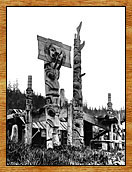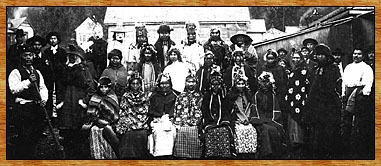 
(Page 3 of 3) |
Skidegate
Two visitors to Skidegate within a short time of each other provide an insight into Haida ceremonial life as the final curtain fell. Reverend William H. Collison of Masset, who visited Skidegate in 1876 with Albert Edward Edenshaw and his son Cowhoe (later baptized George), describes his reception thus:
Cedar bark mats were spread for us to the rear of the lodge in the centre . . . Water, soap, and towels were first brought, and each of us invited to wash our hands. The first food offered us was dried salmon and eulachon grease . . . The next dish was boiling dulse, which, when gathered, is made up into square cakes about twelve inches by twelve and about one and a half inches in thickness, and dried in the sun. Before boiling, this is chopped fine, and it is also mixed with eulachon grease before being served out. Large horn spoons were then handed round, those given to the chiefs being inlaid with abalone or mother-of-pearl. As a special mark of honor, I was given a large silver-plated tablespoon, which became so heated with the boiling seaweed that I could not permit it to touch my lips. Accordingly I called upon them to change it for one of their horn spoons. This caused much hilarity among them to find that the Yetz haada preferred a spoon of their manufacture to that made by his own countrymen.
After this dish we were served with dried halibut and grease, and then with boiled herring spawn. During this repast I had remarked two young men, stripped to the waist, beating up in tubs dried berries with water until it became a frothy substance, not unlike ice cream in appearance. This was served up last as dessert.
Dawson attended a potlatch at Skidegate on 24 July 1878 and furnishes a rich description of the proceedings:
The smoke from the fire, -- which the only light -- escaping by wide openings in the roof . . . The performers in this instance about twenty in number, dressed according to no uniform plan but got up in their best clothes, or at least their most gaudy ones, with the addition of certain ornaments &c. appropriate to the occasion. All or nearly all wore head dresses, variously constructed of cedar bark rope ornamented with feathers &c. or as in one case with a bristling circle of the whiskers of the Sea-lion. Shoulder girdles made of Cedar-bark rope, variously ornamented & coloured, with tassels &c. very common. One man wore gaiters covered with fringes of strung puffin bills which rattled as he moved. Nearly if not all held sprigs of fresh spruce, & were covered about the head with downy feathers which also filled the warm atmosphere of the house. Rattles were also in order. Different from the rest however, five women who stood in front, dressed with some uniformity, Several having the peculiarly beautiful mountain goat shawls which are purchased from the Mainland Indians. The head-dresses of these women were also pretty nearly the same consisting of Small mask faces Carved in wood & inlaid with haliotis [abalone] shell, these Attached to Cedar bark & built round with gay feathers &c. stood above the forehead. The faces of the women -- as if All engaged in the dance -- gaily painted, vermillion being the favourite colour.
Another important feature the master of the ceremonies, who stood in the middle of the back row, slightly higher than the rest, not particularly gaily dressed, but holding a long thin stick with which he kept time & lead off the singing . . .
The performer on the drum -- a flat tambourine-looking article formed of hide stretched on a hoop -- Sat opposite the dancers & near the fire, So that they Could mutually see each others movements. The drum beaten very regularly in "double knocks," thus -- tum tum--tum tum--tum tum -- &c!
With this the dancers kept time in a sort of Chant or Song to which words appeared Set, & which rose to a loud pitch or fell lower according to the motions of the Master of the Ceremonies, who besides keeping up the time now & then slips in a few words of direction or exhortation. To the drumming the dancing also keeps time, following it closely . . . When the chorus swells to forte, the rattles are plied with tenfold vigour & the noise becomes very great. After a performance of ten Minutes or so the Master of Ceremonies gives a sign & all stop, ending with a loud Hugh! After a few minutes repose the movement begins again, with the drum.
The people of Skidegate asked Reverend William Duncan of Metlakatla to send a missionary to them, and he sent Edward Mathers, a Tsimshian teacher. This was not what the Haida wanted, so they sent a party led by Chief Nanjingwas to Metlakatla to plead their case again with Reverend Duncan: "You have gone to Masset . . . and made your residence there, while you have only sent a Tsimshian to teach us. This is not as it should be, as Skidegate was formerly just as powerful as the north, and we should have a white teacher also." This statement illustrates the long-standing rivalry between Skidegate and Masset, and between the Haida and the Tsimshian peoples. That rivalry was one of the driving forces in the production of impressive artworks that are now considered of world significance.
The Methodist mission at Fort Simpson sent the Haida a white teacher, George Robinson, in 1883. The effects of a permanent mission at Skidegate were rapid and profound. Within a year, the traditional plank houses were replaced with single-family dwellings of frame construction, and the rows of houses along the shore were replaced with streets on a grid pattern. The church became the major focus of community life, though there is no evidence that totem poles were destroyed at the instigation of missionaries, as had happened at Masset.

 |
The frame of the abandoned Grizzly Bear House at Skidegate. The waning fortunes of this family are revealed by the shack they have built inside the frame of their former dwelling.
Photograph by Richard Maynard, 1884.
CMC 67236 |

Edward Dossetter, a Victoria photographer aboard the ship Rocket, had stopped at Skidegate in 1881 and took some excellent photographs. At the time of his visit, several new houses were under construction and a few new memorial poles had been raised, but this activity marked the end of the erection of traditional monuments in the village; the few remaining master carvers received no new commissions after the mid-1880s.
In 1884, when Richard Maynard, another Victoria photographer who accompanied Newton H. Chittenden on a provincial survey of the Queen Charlotte Islands, visited Skidegate, most of the old houses had been pulled down or were in ruins and many poles had fallen. The people of Skidegate had decided to adopt the ways of the white man.


A number of young Skidegate women wearing secret society regalia are surrounded by men, including Chief Tom Price (right) in a white shirt. Reverend Charles Harrison arranged this photograph in 1890 in an attempt to discourage face painting, masks and secret societies.
Photograph by Reverend Charles Harrison.
CMC 71-6778 |

|